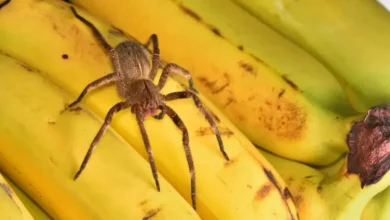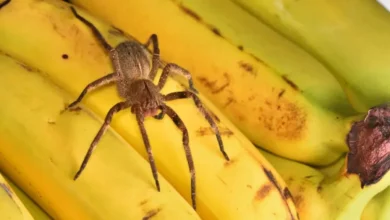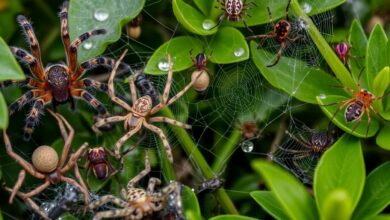Discover Fascinating Types of Spiders in Your World
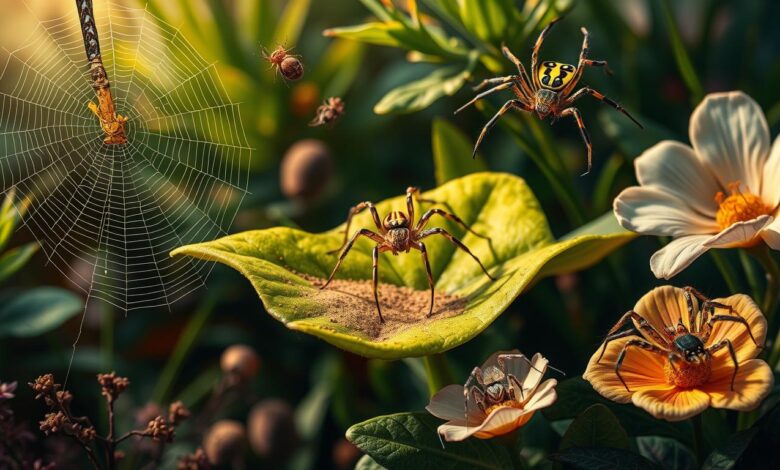
Spiders are fascinating creatures with many shapes, sizes, and behaviors. From the quick jumping spider to the big tarantula, they show incredible diversity. This article will show you the different types of spiders you might see, their homes, webs, and how they hunt.
Get ready to be amazed by these eight-legged wonders that live with us.
The Incredible Diversity of Spider Species
The spider world is full of diversity. You can find tiny jumping spiders and huge tarantulas. We’ll explore the smallest and largest spiders, showing how different they can be.
From Tiny to Towering: Spider Sizes Revealed
The Patu digua is the smallest spider, found in Colombia. It’s only 0.37 millimeters long. On the other end, the Theraphosa blondi, or Goliath birdeater, can have a leg span of up to 12 inches. These sizes show how spiders can adapt to different places.
| Spider Species | Size | Habitat |
|---|---|---|
| Patu digua | 0.37 mm body length | Colombia |
| Theraphosa blondi | Up to 12 inch leg span | South America |
Venomous vs. Non-Venomous: Unraveling the Mystery
Spiders come in two types: venomous and non-venomous. Not all spiders can hurt humans. Most spiders are safe, but a few can be dangerous. Knowing this helps us understand spiders better.
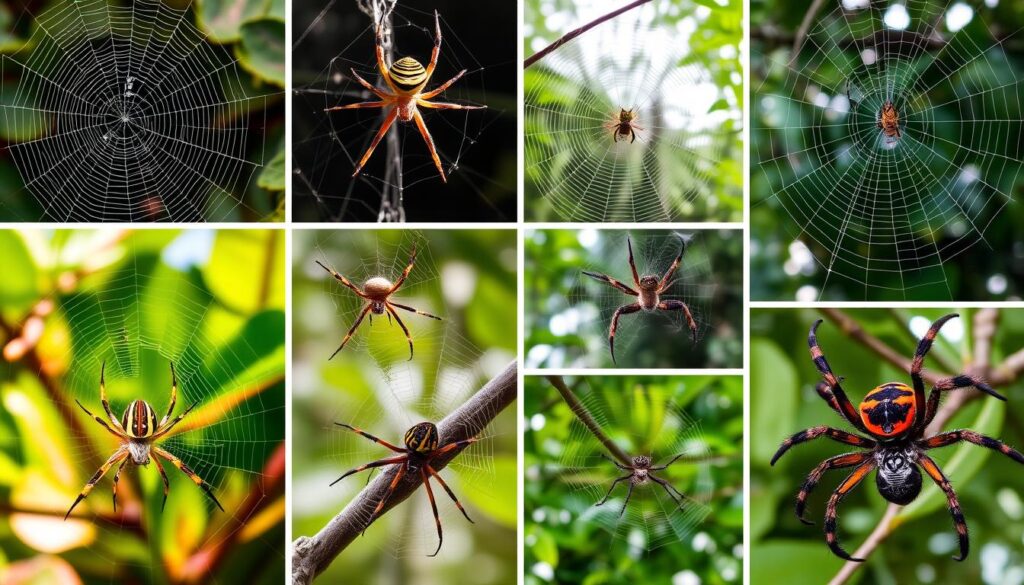
Unraveling the Web: Spider Habitats Uncovered
Step into the fascinating world of spider habitats. These eight-legged wonders thrive in many environments. From backyards to rainforests, spiders adapt well, showing their resilience and importance in ecosystems.
In cities, spiders spin webs in buildings, using every nook for shelter and hunting. They live alongside humans, often unseen as they catch prey and balance their ecosystems.
In the wild, spider habitats are vast and varied. Spider Sophie, a Common Garden Spider, was found in 2015 in the Amazon rainforest. She’s just one example of spiders’ amazing adaptations for survival.
Spiders live in deserts, forests, and everywhere in between. They use different strategies to survive, like the trashline orb weaver and the cobweb spinner. These spiders thrive in unexpected places, weaving into the natural world.
Exploring spider habitats reveals a world full of fascinating adaptations and mysteries. Join us as we discover where spiders live and their unique environments.
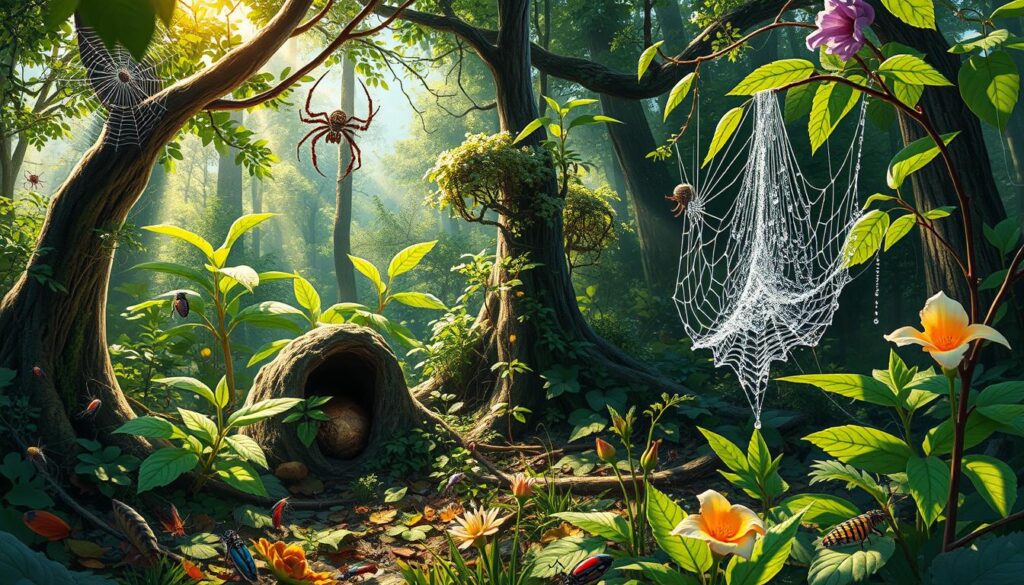
Spinning Masterpieces: Exploring Spider Web Architecture
Spiders are known for their amazing web-spinning skills. They create detailed, geometric webs or messy tangles of silk. We’ll explore the amazing designs of orb weavers and the messy beauty of cobweb spinners. Learn how these spiders use their skills to make incredible webs.
Orb Weavers: The Geometric Geniuses
Orb weavers are the top architects among spiders. They make perfect, wheel-shaped webs with fine radial spokes and spiral threads. Their webs can grow up to several feet wide, showing their amazing skill.
Building an orb web is a precise dance. The spider lays down the web’s framework and then adds the spiral silk. This web is not just a trap but also a display of the spider’s art and problem-solving.
Cobweb Spinners: The Masters of Chaos
Cobweb spiders create messy, irregular webs. These webs are often found in corners or hidden spots. Despite looking random, they are traps for prey that gets caught in their sticky strands.
Cobweb spiders use a special strategy. They spin tripwires and anchors, then add a maze of threads. This creates a complex, three-dimensional web that’s both beautiful and effective. It shows their adaptability and problem-solving skills.
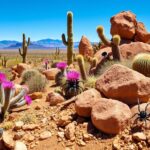 Discover Spiders in Arizona: Your Ultimate Guide
Discover Spiders in Arizona: Your Ultimate Guide
Predator and Prey: Spider Hunting Behaviors Demystified
Spiders are fascinating predators with many clever ways to catch their prey. The jumping spider is known for its fast moves. The crab spider waits patiently for its next meal. These spiders’ hunting methods are truly captivating.
The orb-weaver spider is amazing. It builds complex webs to catch insects. When an insect gets stuck, the spider bites it with venom.
Cobweb spiders have a different method. They make messy webs that look like a cobweb. They wait in the middle of their web for prey to get caught, then they attack.
But spiders don’t just sit and wait. Some, like the jumping spider, chase their prey. They use their great eyesight to find and catch their food.
Spiders also help keep their ecosystems balanced. By eating insects and small creatures, they keep populations in check. This helps keep their environments healthy and diverse.
Learning about spiders’ hunting behaviors is fascinating. It shows us the complex web of life around us. From the crab spider’s patience to the jumping spider’s speed, their hunting skills are amazing.
Arachnid Anatomy: A Closer Look at Spider Physiology
Spiders are amazing creatures with unique bodies. They have special parts and ways to live in different places. Let’s explore their anatomy and how they adapt to various environments.
Eight-Legged Wonders: Exploring Spider Body Parts
At the heart of a spider is its cephalothorax. It’s where the head and thorax meet. Here, you’ll find the spider’s important organs like the nervous and digestive systems.
From the cephalothorax, eight legs extend. Each leg has sharp claws and sensory organs. These help the spider move and find food.
The abdomen, or opisthosoma, is where the digestive system and silk glands are. Spiders use these glands to make webs. The abdomen also has the respiratory system, which can be different for each spider.
Spiders have fangs, or chelicerae, for biting and venom. They also have pedipalps. These help with eating, mating, and other important tasks.
| Spider Body Part | Function |
|---|---|
| Cephalothorax | Fused head and thorax region housing vital organs |
| Legs | Equipped with claws and sensory organs for navigation and prey detection |
| Abdomen | Contains digestive system, silk glands, and respiratory system |
| Fangs (Chelicerae) | Used for biting and injecting venom into prey |
| Pedipalps | Sensory and manipulative appendages assisting in feeding, mating, and other functions |
Spiders have amazing anatomy and physiology. Each part is vital for their survival. Learning about these details helps us see how diverse and adaptable spiders are.
The Good, the Bad, and the Venomous: Understanding Spider Venom
Spider venom is a fascinating topic. These eight-legged creatures have many toxins. Some venom is for defense, while others can be very dangerous to humans.
Deadly Encounters: Venomous Spider Species to Avoid
Knowing about dangerous spiders is key. Venomous spiders like the Black Widow, Funnel-web Spider, and Brazilian Wandering Spider have strong toxins. These can cause muscle pain, nausea, and even death. It’s best to stay away from these spider bites.
| Venomous Spider Species | Venom Potency | Geographic Range |
|---|---|---|
| Black Widow | Highly Venomous | North America, Central America, South America, Europe, Asia |
| Funnel-web Spider | Extremely Venomous | Eastern Australia |
| Brazilian Wandering Spider | Extremely Venomous | South America |
Most spider species are not dangerous to humans. Their spider venom is usually harmless or not strong enough to harm us. Learning about spider venom helps us understand and safely interact with these creatures.
types of spiders: A Comprehensive Guide to Spider Identification
Exploring the world of spiders is both exciting and challenging. It’s great for nature lovers, budding arachnologists, or anyone curious about eight-legged creatures. This guide will help you learn to identify the different types of spiders you might see.
Each spider species has its own special traits. For example, orb weavers create beautiful geometric webs, while crab spiders hide in the shadows. By looking at body shape, leg length, color, and web patterns, you can spot spiders easily.
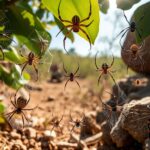 Discover Texas Spiders: Your Guide to Local Arachnids
Discover Texas Spiders: Your Guide to Local Arachnids
We’ll explore the amazing world of spider identification together. You’ll learn about the variety of arachnids in different places. From the big tarantulas in the Southwest to the tiny jumping spiders in your garden, you’ll discover what makes each spider unique.
| Spider Species | Distinctive Features | Habitat |
|---|---|---|
| Black Widow Spider | Shiny black body with a distinctive red hourglass shape on the underside | Found in dark, sheltered areas like wood piles, garages, and undisturbed corners |
| Orb Weaver Spider | Large, round body with intricate, symmetrical spiral web patterns | Commonly found in gardens, parks, and wooded areas |
| Jumping Spider | Small, chunky body with large, forward-facing eyes and the ability to jump long distances | Commonly found on walls, foliage, and in crevices |
Learning about different spider species makes you a better spider identifier. Discover the amazing diversity of these arachnids and explore their world.
From Backyard to Rainforest: Spider Species Around the World
The world is full of amazing spider species. You might see house spiders in your backyard. But, the rainforest is home to huge, exotic spiders. Exploring the world of spiders will amaze you with their variety.
Exotic Arachnids: Encountering Unique Spider Species
There are many unique spiders around the world. For example, peacock spiders have grown in number. In 2011, there were seven in Australia. Now, there are over 70, with more than 70 in Western Australia.
These spiders are known for their bright colors and dance-like moves. New species, like the Maratus hakea, are still being found. Even tiny spiders, like the starry night peacock spider, have their own stories.
Exploring from your backyard to the rainforest reveals a world of spider species around the world. You’ll find everything from peacock spiders to other fascinating arachnids. The global spider diversity shows the incredible variety of exotic spider species on our planet.
Harmless Roommates or Unwanted Guests? Dealing with Spider Control
Spiders are important in our ecosystem, but they can be a nuisance in our homes and workplaces. Whether it’s a single web or a big spider problem, knowing how to control them is key. It’s important to use humane methods to manage spider populations.
First, learn about the spiders in your area. Knowing which spiders you have can tell you if they’re harmless or not. Many common spiders, like cellar spiders and daddy longlegs, are not dangerous. They even help control other insects.
To control spiders, start by sealing up your home. Fix cracks and gaps around windows and doors. This stops spiders from getting in. Also, clean and vacuum regularly to remove webs and eggs.
If spiders are a big problem, try natural repellents like essential oils or diatomaceous earth. These are safer and better for the environment than chemical sprays. If these methods don’t work, you might need a pest control service.
Even though spiders might be unwanted, they’re important to our ecosystem. Try to live with them peacefully or remove them safely. With the right knowledge and approach, you can manage spiders without harming them.
| Spider Control Strategies | Benefits |
|---|---|
| Seal entry points | Prevents spiders from entering the home |
| Regular cleaning and vacuuming | Removes webs and egg sacs, disrupting the spider’s life cycle |
| Use natural repellents | Safer and more environmentally friendly than chemical pesticides |
| Call a professional pest control service | Effectively eliminates persistent spider infestations |
Spider Myths and Legends: Separating Fact from Fiction
Spiders have been surrounded by myths and legends for a long time. These myths often lead to irrational fears and misunderstandings. From old stories to new ones, spiders have fascinated people worldwide. Let’s look at some common spider myths and see what’s true and what’s not.
Arachnophobia: Overcoming the Fear of Spiders
Many people fear spiders, a fear known as arachnophobia. This fear affects up to 15% of the population. But, most spiders are not dangerous to humans. Only a few can have venom that could be deadly.
Beating arachnophobia starts with learning about spiders. By understanding their behaviors and how they adapt, people can face their fears. Also, talking to a therapist can help manage and lessen arachnophobia symptoms.
| Spider Myths | Reality |
|---|---|
| Spiders are aggressive and will intentionally attack humans. | Most spiders are not aggressive and will only bite humans in self-defense or when accidentally trapped or disturbed. |
| Spider bites can cause severe illness or death. | Only a small percentage of spider species have venom that can be harmful to humans, and most spider bites result in mild reactions similar to a bee sting. |
| Spiders can jump long distances to attack their prey. | While some spiders can jump short distances, they do not possess the ability to leap great distances or attack humans in that manner. |
By learning the truth about spiders, we can overcome our fears. This knowledge helps us see the amazing diversity and importance of spiders in our world. Education and exposure can clear up the myths about spiders and give us a better understanding of these fascinating creatures.
Conserving Arachnid Allies: The Importance of Spider Protection
Spiders are key players in their ecosystems, acting as both predators and prey. They help control insect numbers, which is crucial for agriculture and health. But, many spider species are at risk due to habitat loss, pesticides, and fear.
It’s important to protect spider conservation. Preserving their habitats helps these amazing creatures thrive. We should support efforts to protect forests and grasslands. Also, we need to adopt sustainable land use to reduce harm to spiders.
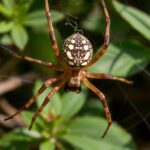 Hobo Spiders: Facts and Tips for Your Home
Hobo Spiders: Facts and Tips for Your Home
Education is also vital in protecting spiders. By sharing true facts and debunking myths, we can build a better understanding of spiders. Programs and outreach can teach people about spiders’ importance. This way, we can ensure their survival for the future.
